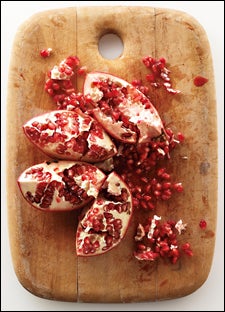The longevity king is bonking. We’re seven miles into a ten-mile Rollerblading circumnav┬şigation of Minneapolis’s urban lake chain when he pulls off to sprawl on a park bench.
Food for longevity
 Genes dictate as little as 10 percent of our life expectancy, says Buettner
Genes dictate as little as 10 percent of our life expectancy, says BuettnerA diehard Minnesotan, Dan Buettner, 49, author of the bestselling The Blue Zones: Lessons for Living Longer from the People Who’ve Lived the Longest, is crazy for the low-impact, joint-friendly sport and couldn’t care less that, outside of Paris, it’s gone the way of the mullet. It’s a different longevity rule┬Śslowing down to deal with stress┬Śthat Buettner is struggling with this morning. After a furiously paced 20 hours of work, which began yesterday at 7 A.M. and ended this morning at 3 A.M., he’s feeling the burn.
Last night, Buettner hosted a dinner party celebrating the Vitality Project, in which he’s applying the nine lessons in The Blue Zones to the residents of Albert Lea, a former meatpacking town 90 minutes south of Minneapolis. Funded by the United Health Foundation and AARP, the program’s ambitious goal is to add a collective 10,000 years of life expectancy to its 18,000 residents.
“Everybody has to sit by someone they don’t know!” Buettner proclaimed at dinner. As the sun set over Lake of the Isles in front of his house, a dozen or so guests┬Śincluding the project’s co-director, Brian Wansink, a Cornell professor and the author of Mindless Eating: Why We Eat More Than We Think; Hollywood director Rob Perez, in town to film his comedy Nobody; and Horst Rechelbacher, the Austrian founder of Aveda┬Śdined on seafood and a heaping platter of roasted vegetables accompanied by cannonau, a Sardinian red wine with triple the age-fighting antioxidants of other varietals. Then Buettner brought out the Patr├│n Silver.
“After last night’s tequila, you could just lick my arm and suck a lime,” Buettner jokes. “I may be a conduit for what the longest-lived people do, but I’m not the emblem. Don’t necessarily do as I do; do as I say!”
What Buettner says can be boiled down to nine main prescriptives he and a team of researchers culled from a six-year project in the four places in the world┬ŚLoma Linda, California; Okinawa, Japan; Sardinia, Italy; and Costa Rica’s Nicoya Peninsula┬Śwhere the population hits age 100 at an impressively high and healthy rate. These “Power 9,” as he’s dubbed them in familiar self-help jargon, are as follows: (1) Move naturally. (2) Eat until you’re 80 percent full. (3) Base your diet on whole grains, beans, garden vegetables, and nuts, while avoiding meats and processed foods. (4) Drink red wine in moderation. (5) Have a plan de vida, or purpose. (6) Participate in a spiritual community. (7) Make family a priority. (8) Surround yourself with people who have similar values. (9) Take time to relieve stress.
While most of the individual prescriptives in The Blue Zones might seem intuitive, the book’s surprising thesis is what has made it a bestseller. For years, conventional wisdom held that longevity was mostly a result of genetic luck; if your parents passed away in their sixties, you probably weren’t going to be blowing out candles at age 90, either. Oh, well, pass the butter! But Buettner’s book argues that we have a lot more control over our life span than we once thought.
“Genes dictate as little as 10 percent of our life expectancy,” he says. “The populations I’ve studied live longer because of lifestyle.” In fact, according to Buettner, if the average American practiced the Power 9 for most of his life, he could live an additional 12 healthy years.
Since his book debuted in 2008, Buettner has become America’s go-to longevity guy, a regular on shows from Good Morning America to Oprah to Dr. Oz, and a guru to a generation of rapidly aging boomers. But if you’re thinking that most of what Buettner advises doesn’t apply until you turn 50, he’s here to correct you.
“We age exponentially,” he warns. “The technical definition of aging is a buildup of molecular and cell damage. When your cells reproduce every eight years, the damage doubles.” Do the math and you’ll find that a 35-year-old has almost four times as much damage as a 20-year-old.
Making choices in your twenties and thirties, in other words, is just as important as it is when you hit your golden years. The question is, what exactly do you have to give up?
FOR STARTERS, Buettner advises you take a hard look at some of your favorite sports. Most blue-zone centenarians have led active lives, but exercise was a natural part of their day, like walking the hills as a shepherd or growing their own food in a garden. If those kinds of activities represent the middle of the spectrum, here in America we tend to focus on the opposing extremes, either spending too much time on the couch or abusing our knees running on asphalt. Skiing, running, playing contact sports, or participating in any other high-impact activity at an age when you’re starting to see diminishing returns on your athletic efforts┬Śright around 40┬Ścan wreak havoc on your body. These jarring sports can cause chronic inflammation, warns Buettner, a condition associated with every major age-related disease.
“If you keep up your extreme athleticism,” Buettner says, “you’ll be running up an incline that’s getting steeper every year. I can’t think of a centenarian who engaged in extreme sports for any given time over the course of his or her life.”
To Buettner, there are no downsides to swapping your body-battering routine for a more sustainable one. “Rather than focusing on reliving your youthful glory,” he says, “focus on teaching the next generation how to climb.”
Or expand your definition of “extreme.” “Get really good at yoga,” says Buettner. “Flexibility and joint health are essential as we get older.”
“Get really good at yoga”? On this point, Buettner has provided a good model for Type A athletes to follow. The fit, six-two author earned his chops in his twenties and thirties as a world-class endurance athlete. In 1986┬ľ87, Buettner cycled from Alaska to Argentina. In 1990, he and his brother Steve cycled around the world, from their hometown of St. Paul, Minnesota, and back, via Europe and the Soviet Union. Then, in 1992, they set out again, this time going from Tunisia to South Africa. Buettner would eventually ride across six continents, earning three Guinness world records for endurance cycling. Starting in 1995, he spent a decade traveling the world with a host of experts, founding “Quests,” a string of expeditions to solve scientific mysteries, harnessing the Internet to combine exploration with virtual classroom education. (In 2000 and 2001, I worked as the team science writer for two Quests.)
But while he was in Okinawa, in 2000, Buettner became fascinated by the habits of centenarians he’d met. He went back in 2003 to pursue more longevity research, resulting in an award-winning 2005 cover story in National Geographic.
“I segued from extreme adventure to extreme other things,” he says. “I’ve done 21 pretty hardcore expeditions, but I did a ten-day silent vipas┬şsana meditation retreat that was as hard as anything I’ve ever done.”
Save for a few occasional vices, like tequila and black Twizzlers, Buettner’s diet is relatively stringent, too. He starts the day with a fruit smoothie and organic whole-grain bread, takes vitamin C and fish oil, and makes sure he bares his chest in the sun as often as he can for a dose of vitamin D. (Scientists now say that 10 to 15 minutes of sun exposure without sunblock twice a week helps reduce rates of cancer, depression, and chronic pain.) For lunch and dinner, he eats beans, tofu, broccoli, seaweed, and anything leafy. “I don’t buy meat for my house, but if it’s served elsewhere, I’ll eat it,” he says. And for a snack, nuts. Always nuts (almonds, pistachios, peanuts┬Śany kind of nut will do).
Self-graded on his own Power 9, Buettner’s report card looks like this: Move naturally, A+; eat until 80 percent full, B+; eat plant-based foods, B+; drink red wine in moderation, A+; have a purpose, A; participate in a spiritual community, B┬ľ; make family a priority, B+; surround yourself with the right people: A; downshift to relieve stress: B┬ľ.
As his stress-relief grade suggests, Buettner struggles with slowing down. He’s trying to stay put to spend more time with his three kids, the youngest of whom has cerebral palsy. But there are distractions. Between new research, media engagements, meeting with editors, and networking, Buettner spends between five and 15 days a month on the road. “I’m not striving to get A’s in everything,” he says. “It’s a mistake to impose hard rules on people. I don’t walk around and say to myself, ‘I’ll live two days longer if I don’t do this shot of tequila.’ I don’t have an overwhelming desire to live longer, but the Vitality Project has been by far the most rewarding thing I’ve ever done.”
INDEED, the changes Buettner and his makeover team instituted in Albert Lea have been transformative. For the statistically average American town┬Śwhere 38 percent of the resi┬şdents are overweight and 24.5 percent are obese┬Śthe Vitality Project volunteers organized 700 of the 4,217 participants into walking groups called moais, a term Buettner picked up in Japan that, loosely translated, means “a group of lifelong friends.” Those residents collectively walked more than 75 million steps. Additionally, volunteers completed a seven-mile path around Fountain Lake and planted 46 community gardens. The average participant lost three pounds, and health-care costs among city workers are down 48 percent from last year. Impressed, officials from 18 cities across the country, including Lincoln, Nebraska, and Nashville, Tennessee, are in talks with Buettner about turning their cities into blue zones.
At the start of the Vitality Project, in May, every participant answered questions in a scientifically formulated survey called the Vitality Compass, which spits out the person’s projected date of expiration based on his or her lifestyle habits. In October, everyone took the test again. The average gain in life expectancy was 3.1 years.
No one would argue with the results the blue-zone tenets have had, but if there’s a knock against Buettner, it’s that he sometimes deals more in generalities than in hard data backed by rigorous scientific method. His methodology for The Blue Zones involved plenty of research, and the book is filled with evidence that backs his Power 9 findings. But Buettner isn’t a scientist.
“There’s nothing Dan is arguing that’s wrong,” says Robert Kane, director of the University of Minnesota’s Center on Aging and a longtime consultant for The Blue Zones. “But he’s more willing to say something should be done than I am, because I have a higher standard of empiricisms. For example, Dan pushes eating nuts. It’s probably a much more complicated story than eating nuts. That’s like saying if I wear Brett Favre’s T-shirt I’ll be a good quarterback.”
The same could be said about his views on exercise. His theories don’t always allow for gray areas. For example, Buettner’s opinion on high-impact sports doesn’t explain men like George Hirsch. The 75-year-old chairman of the board of the New York Road Runners recently ran the 2009 Chicago Marathon in 3:58:42. A month later he ran the New York City Marathon in 4:06:14.
“Scientists do need to have a higher level of empiricisms,” Buettner says, “but they also told us that we should eschew butter for margarine. Now we find out that margarine has toxic trans fats. Science is not infallible. The beginning and end of my expertise is this: what the world’s longest-lived people do and suggestions on how to apply those principles to the lives of people.”
NOW THAT Buettner has given us a road map for living to 100, he’s turned his attention to another elusive human condition: happiness. His next book, Thrive: How to Live Like the World’s Happiest People, comes out next fall. To research Thrive, he’s applied the same technique he did with The Blue Zones, partnering with National Geographic and other researchers to identify the happiest places in the world, then studying the characteristics of the residents there to give readers prescriptive lessons on their behaviors.
A cynic could accuse Buettner of simply tapping into another American obsession to expand his franchise, but Buettner says he’s been interested in happiness since the early eighties, when he interviewed George Plimpton for a story about Ernest Hemingway for The Minnesota Daily. In the story, Buettner pondered whether Hemingway, who’d had four wives and blew his brains out at age 61, was ever happy. His conclusion: “There’s an inverse relationship between happiness and overaccomplishment.”
That’s interesting coming from an ambitious man who rates himself a nine on the happiness scale.
“If I had to boil happiness down to one key,” Buettner tells me as we sit down to a post-Rollerblade dinner at a Thai restaurant a few blocks from his house, “it would be to surround yourself with the right people. Friends have a long-term, measurable, demonstrable impact on us. Are the ten people you spend most of your time with grateful? Are they trusting and trustworthy? Do they nudge you toward physical activity? Do they make you laugh?”
If your friends don’t have these qualities, Buettner advises you to be aware that they’re having a toxic effect on you.
If Buettner has formulated a Power 9 for happiness, he doesn’t divulge it this evening. Which is good, because I’m still floundering with his first Power 9. Right after I stick a forkful of delicious green-curry walleye in my mouth, Buettner motions for the hovering waiter to take my plate away. Apparently, he’s noticed that I’m 80 percent full.


